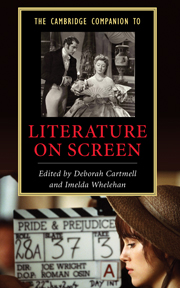Book contents
- Frontmatter
- Introduction - Literature on screen: a synoptic view
- Part One Theories of Literature on Screen
- Part Two History and Contexts
- 3 Gospel narratives on silent film
- 4 William Shakespeare, filmmaker
- 5 The nineteenth-century novel on film: Jane Austen
- 6 Modernism and adaptation
- 7 Postmodern adaptation: pastiche, intertextuality and re-functioning
- Part Three Genre, Industry, Taste
- Part Four Beyond the "Literary"
- Further reading
- Index
- Series List
4 - William Shakespeare, filmmaker
from Part Two - History and Contexts
Published online by Cambridge University Press: 28 September 2007
- Frontmatter
- Introduction - Literature on screen: a synoptic view
- Part One Theories of Literature on Screen
- Part Two History and Contexts
- 3 Gospel narratives on silent film
- 4 William Shakespeare, filmmaker
- 5 The nineteenth-century novel on film: Jane Austen
- 6 Modernism and adaptation
- 7 Postmodern adaptation: pastiche, intertextuality and re-functioning
- Part Three Genre, Industry, Taste
- Part Four Beyond the "Literary"
- Further reading
- Index
- Series List
Summary
It has become a popular commonplace that had Shakespeare been born in the twentieth century, he would have been a filmmaker. This idea has had a long history, stretching back at least as far as George Méliès's 1907 film La Mort de Jules César. In it, Shakespeare, suffering from writer's block, falls asleep. As he does, he dreams of the assassination scene from Julius Caesar, presented behind him in one of the double-exposure shots for which Méliè s was renowned. His writing problems solved, Shakespeare awakes with delight and even stabs a loaf of bread, imitating what he has just seen. The effect is to reverse the usual relationship between Shakespeare's theatrical script and the cinematic image of Caesar's murder. As Méliès presents the writing process, one of Shakespeare's most famous scenes springs from an imagination not bound to the stage, an imagination fundamentally visual not verbal. The final shot, of Shakespeare's face surrounded by the flags of many nations, suggests that his international appeal springs not from his words but from the moving images that lie behind them. It suggests that the essentially visual - and thus panlinguistic - nature of Shakespeare's imagination, like that of silent film, makes his work capable of crossing cultural boundaries. Shakespeare and film, Méliès argues, are conjoined at an essential level. Something of this same idea appears in the final moments of Shakespeare in Love (John Madden, 1998). Again, the scene is of Shakespeare composing. Having lost his love but gained a royal commission, Shakespeare sits down to write Twelfth Night.
- Type
- Chapter
- Information
- The Cambridge Companion to Literature on Screen , pp. 61 - 74Publisher: Cambridge University PressPrint publication year: 2007
- 7
- Cited by



